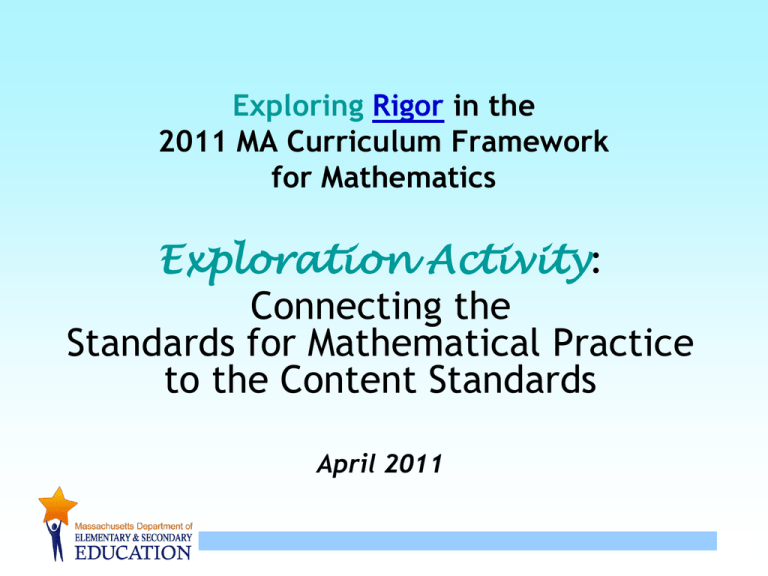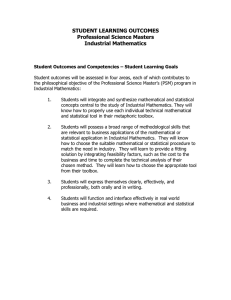rigor
advertisement

Exploring Rigor in the 2011 MA Curriculum Framework for Mathematics Exploration Activity: Connecting the Standards for Mathematical Practice to the Content Standards April 2011 1 Desired Outcomes After this activity participants will: • Be familiar with the format and terminology of the Standards for Mathematical Practice. • Understand how the practice standards bring rigor to the grade level standards. • Understand the difference and connection between the Standards for Mathematical Practice and the grade level content standards. 2 Supporting changes in practice • The new standards support improved curriculum and instruction due to increased: – FOCUS, via critical areas at each grade level – COHERENCE, through carefully developed connections within and across grades – CLARITY, with precisely worded standards that cannot be treated as a checklist – RIGOR, including a focus on College and Career Readiness and Standards for Mathematical Practice throughout Pre-K-12 3 Background Information: Standards for Mathematical Practice “These practices rest on important ‘processes and proficiencies’ with longstanding importance in mathematics education.” (Massachusetts Curriculum Frameworks for Mathematics, 2011, p. 15) •The NCTM process standards (2000) •The National Research Council’s report Adding It Up (2001) 4 NCTM – Principles & Standards for School Mathematics Process Standards The five standards address the processes of •Problem solving •Reasoning and proof •Connections •Communication •Representation 5 Intertwined Strands of Proficiency p. 117 Adding It Up: Helping Children Learn Mathematics By Jeremy Kilpatrick, Jane Swafford, & Bob Findell (Editors). (2001). Washington, DC: National Academy Press 6 Standards for Mathematical Practice 1. Make sense of problems and persevere in solving them. 2. Reason abstractly and quantitatively. 3. Construct viable arguments and critique the reasoning of others. 4. Model with mathematics. 5. Use appropriate tools strategically. 6. Attend to precision. 7. Look for and make use of structure. 8. Look for and express regularity in repeated reasoning. 7 Grade Level Overview Page 8 Standards for Mathematical Content • Content standards are a balanced combination of procedure and understanding. • Content standards that set an expectation of understanding are potential “points of intersection” between the content standards and the practice standards (see p. 17 of the Math Framework). − A lack of understanding of mathematical content effectively prevents a student from engaging in the mathematical practices. 9 Session Overview • Warm-up focusing on Standard for Mathematical Practice #4: Modeling (10 minutes) • Main activity matching a focus practice standards to strongly connected content standards, and examples to justify each match (30 minutes) • Whole group discussion about impacts on teaching and learning (10 minutes) 10 Warm-Up : Examining Standard 4 Model with Mathematics Read Practice Standard #4 – Model with Mathematics (see p. 16 of the Math Framework) • Underline important language (words and phrases) that help you remember the essence of this practice. How might students use this practice standard at the grade level you teach? Share at least one of your ideas with your grade-level group. Time estimate: 10 minutes 11 Main Activity: Connecting Content and Practices Standards 1. Choose one Standard for Mathematical Practice as a focus of this activity. 2. Underline important language (words and phrases) that help you remember the essence of this practice. 3. Look through the Content Standards for the grade level you teach. 4. Identify 3-5 Content Standards that would address your focus mathematical practice. 5. Justify each match with an example. Time estimate: 20 minutes 12 Main Activity: Small Group Share Share with your group at least one of your examples of a content standard aligned with the standard for mathematical practice you chose as a focus. Time estimate: 10 minutes 13 Wrap-up: Whole Group Discussion • How will incorporating the Standards for Mathematical Practice impact teaching and learning, including: – Planning for instruction? – Rigor? – Student learning as they progress through the grades? •How will you begin to integrate these practices in your classroom? Time estimate: 10 minutes 14 Feedback and Information • To provide feedback on this activity as a facilitator or participant, or to find more activities and resources, go to the ESE’s Curriculum and Instruction page at: http://www.doe.mass.edu/candi/commoncore/ 15




